Molecular mechanisms of pituitary organogenesis: In search of novel regulatory genes
- PMID: 20025935
- PMCID: PMC2909473
- DOI: 10.1016/j.mce.2009.12.012
Molecular mechanisms of pituitary organogenesis: In search of novel regulatory genes
Abstract
Defects in pituitary gland organogenesis are sometimes associated with congenital anomalies that affect head development. Lesions in transcription factors and signaling pathways explain some of these developmental syndromes. Basic research studies, including the characterization of genetically engineered mice, provide a mechanistic framework for understanding how mutations create the clinical characteristics observed in patients. Defects in BMP, WNT, Notch, and FGF signaling pathways affect induction and growth of the pituitary primordium and other organ systems partly by altering the balance between signaling pathways. The PITX and LHX transcription factor families influence pituitary and head development and are clinically relevant. A few later-acting transcription factors have pituitary-specific effects, including PROP1, POU1F1 (PIT1), and TPIT (TBX19), while others, such as NeuroD1 and NR5A1 (SF1), are syndromic, influencing development of other endocrine organs. We conducted a survey of genes transcribed in developing mouse pituitary to find candidates for cases of pituitary hormone deficiency of unknown etiology. We identified numerous transcription factors that are members of gene families with roles in syndromic or non-syndromic pituitary hormone deficiency. This collection is a rich source for future basic and clinical studies.
Figures



References
-
- Weedon MN, Frayling TM. Reaching new heights: insights into the genetics of human stature. Trends Genet. 2008;24:595–603. - PubMed
-
- Rimoin DL, Cohn D, Krakow D, Wilcox W, Lachman RS, Alanay Y. The skeletal dysplasias: clinical-molecular correlations. Ann N Y Acad Sci. 2007;1117:302–9. - PubMed
-
- Cha KB, Karolyi IJ, Hunt A, Wenglikowski AM, Wilkinson JE, Dolan DF, Dootz G, Finnegan AA, Seasholtz AF, Hankenson KD, Siracusa LD, Camper SA. Skeletal dysplasia and male infertility locus on mouse chromosome 9. Genomics. 2004;83:951–60. - PubMed
-
- Jorge AA, Souza SC, Nishi MY, Billerbeck AE, Liborio DC, Kim CA, Arnhold IJ, Mendonca BB. SHOX mutations in idiopathic short stature and Leri-Weill dyschondrosteosis: frequency and phenotypic variability. Clin Endocrinol (Oxf) 2007;66:130–5. - PubMed
-
- Procter AM, Phillips JA, 3rd, Cooper DN. The molecular genetics of growth hormone deficiency. Hum Genet. 1998;103:255–72. - PubMed
Publication types
MeSH terms
Substances
Grants and funding
LinkOut - more resources
Full Text Sources
Molecular Biology Databases

